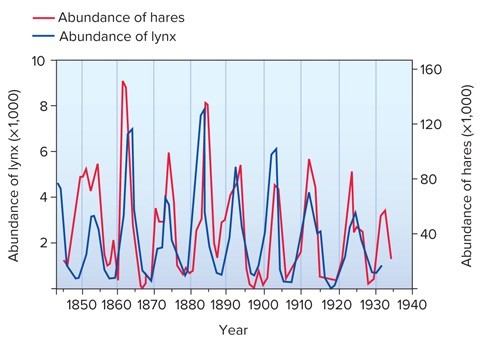 Scientists have discovered that when they provide supplemental food for hares, their density tripled. The figure above shows cycles of lynx and hare populations over a century's time. What do you predict would happen to the lynx and hare populations in an area where hares were provided supplemental food for one year?
Scientists have discovered that when they provide supplemental food for hares, their density tripled. The figure above shows cycles of lynx and hare populations over a century's time. What do you predict would happen to the lynx and hare populations in an area where hares were provided supplemental food for one year?
A. The lynx population would increase 1-2 years after the hares increased, then both would continue cycling down and up.
B. The lynx population and the hare population would increase simultaneously, and stay at a stable high level permanently.
C. The lynx population would decrease as hares increased due to exploitative competition, then slowly rise back to the original level.
D. The hare population would increase, but the lynx population would be unaffected.
Answer: A
You might also like to view...
Sexual reproduction gave rise to complex life cycles seen in eukaryotic organisms
A. true B. false
In Drosophila, the hunchback gene encodes a protein (HB) that is required in the correct concentrations for proper segmentation of the embryo. In the zygote and embryo, the expression of hunchback is stimulated by high concentrations of Bicoid protein. You manipulate a Drosophila embryo to have high Bicoid concentrations throughout. Which of the following would occur?
A. The HB protein would not be produced at all. B. The HB protein would be produced throughout the entire embryo. C. Segmentation would not occur correctly. D. The HB protein would not be produced at all and segmentation would not occur correctly. E. The HB protein would be produced throughout the entire embryo and segmentation would not occur correctly.
What would be considered the control group in this experiment?
a. the Scottish terriers exposed to herbicide b. the Scottish terriers without cancer c. any type of dog that does not have cancer d. all dogs that are exposed to herbicides
Which of the following characteristics indicates that Tiktaalik was an intermediate form between fish and amphibian?
a. The fossil reveals the presence of true lungs, with no gills present. b. Evidence suggests that the eyes were forward facing, similar to a terrestrial predator. c. The attachment of the fin bones to the shoulder suggest that they might be weight bearing. d. The DNA evidence shows that Tiktaalik’s enzymes were adapted for terrestrial habitats.